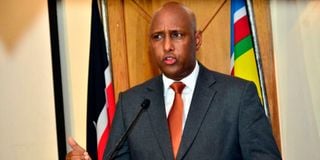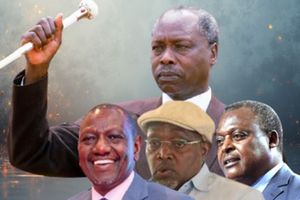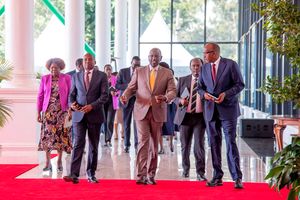Premium
Why is ease of doing business working only in urban counties?

Adan Mohamed, the Cabinet Secretary, Ministry of East African Community and Regional Development.
What you need to know:
- Kenya is set to benefit from more exports and cheap imports with the admission of DRC into the EAC.
- According to the CS, the national government has made deliberate efforts to cater for SMEs by undertaking various targeted initiatives.
Sir, even as Kenya races to make it easy to start and run businesses in the country, it could be that the government is sabotaging itself with a sustained high cost of electricity, corruption and a high tax regime which only gets worse. How do you intend to get to your destination with these factors unresolved, and probably only getting worse? Japhter Muriuki, Germany
The government has been increasing access to electricity and also reducing the cost of electricity through full implementation of the last mile connectivity programme, which on completion, is expected to affordably connect every household to the national power grid. It has also set up an industrial zone in Naivasha where cheap, green energy for industries is being made available for heavy industries.
Under the Ease of Doing Business agenda, the government has been automating and digitising a number of critical government services to the public, in effect reducing costs and improving revenue collection hence reducing wastage of public resources. A majority of services are now on digital platforms.
There are recent and ongoing initiatives on the tax front, such as simplified tax procedures through the i-Tax system. There is enhanced transparency by the Kenya revenue Authority (KRA) and the National Treasury in ensuring a more predictable tax regime and the balance needed to provide crucial government services that call for sustainable tax collection vis-a-vis the prevailing tax rate, which is comparable to other jurisdictions in sub-Sahara Africa.
The government is currently the biggest domestic borrower, thereby locking out SMEs (small and medium enterprises) and other investors and making cost of credit very high. How has this affected the ease of doing business in the country? Given that this is a macro-economic problem, what measures has your team proposed to address the issue? Janerose Akumu, Nairobi
Access to finance is a critical enabler to doing business in every economy. Overall, the banking sector loan book to the private sector is in excess Sh3 trillion. You will also be pleased to note that due to our strong financial markets and groundbreaking initiatives such as the Movable Properties Securities Rights Act of 2016, which has enabled the use of movable assets to access credit, we have seen over Sh1.6 trillion so far on movable collateral credit registered by financial institutions.
The credit information sharing mechanism through Credit Reference Bureaus is another initiative that supports access to credit, as well as funding schemes by government targeting SMEs. We also have the recent credit guarantee scheme, among other key reforms implemented by the government in collaboration with the private sector.
You will be surprised to note that we are ranked fourth globally by the World Bank on access to credit. Of course there is room to do more, especially for SMEs that are still viewed as more risky by lenders.
Bureaucracy is a hindrance to ease of doing business in this region. The sum total of this is the thriving and deep-rooted corruption that is manifested in various forms. What are you doing to address this menace, together with the multiplicity of fees, levies, charges and taxes on import and export of goods and services within the community? Dan Murugu, Nakuru
A lot has been done in the region to facilitate trade and reduce corruption. The implementation of the Single Customs Territory, for example, has enhanced interconnectivity of customs systems leading to maximised efficiency.
The establishment of the One-Stop Border Posts (OSBPS) in the region has facilitated trade, movement of people, and improved security. In an OSBP, border crossing formalities are undertaken in one place by the regulatory agencies of adjoining jurisdictions. An OSBP eliminates the need for travellers and goods to stop twice at borders for border-crossing formalities.
On the elimination of non-tariff barriers (NTBs), the EAC has put in place mechanisms to report and resolve such barriers through the national monitoring committees and regional monitoring committees that meet quarterly.
On multiplicity of fees, levies, charges and taxes on imports and exports within the community, a regional task force has been formed to identify such fees and propose harmonisation or elimination.
Small businesses in this country are going through many challenges. Among the reforms initiated to improve the Ease of Doing Business in Kenya, what is the place of small businesses? Owen Muta, Nairobi
SMEs play an integral role in driving the economy of our country and the national government has made deliberate efforts to cater to this segment of businesses by undertaking various targeted initiatives.
The Ease of Doing Business Agenda is primarily meant for SMEs. For instance, the Companies Act of 2015 is targeted at single owner companies with few requirements, making them faster and efficient to set up. There have been numerous waivers of fees for SMEs such as court filing fees for commercial disputes of up to Sh1 million, National Construction Authority (NCA) fees, National Environmental Management Authority (Nema) fees, and land search and registration fees. The Judiciary has also established the Small Claims Courts tasked with resolving SME disputes within 60 days of filing in order to free-up capital currently tied in disputes.
The Department of Business Reforms and Transformation remains available to receive more feedback and proposals on how it may better serve and impact SMEs.
From my random research on the Ease of Doing Business Reforms project, a lot of focus is on Nairobi, Kisumu, Mombasa and a few other counties with urban centres. Why is that the case, yet there are millions of other small businesses at county level that need to feel the difference? Grace Mburu, Lamu
The national government, under the Ease of Doing Business agenda, has adopted a phased approach in rolling out reforms in the country. In the current phase, reforms are being rolled out in the 10 counties of Garissa, Kakamega, Kajiado, Kisumu, Laikipia, Machakos, Mombasa, Nakuru, Nairobi and Uasin Gishu. The government will build on the successes and lessons learnt during this phase to roll out similar initiatives in the other counties.
All the six Regional Development Authorities (RDAs) under your ministry have put a lot of focus on agriculture for food security enhancement. Even the dams they have constructed are meant to help with irrigation. Despite this, the impact of these RDAs across the country is hardly felt in so far as food security is concerned. What could be the problem? Jackton Mwamba, Kakamega
The river basins which define RDAs are endowed with various natural resources with huge potential. In exploiting the agriculture potential in Kenya, RDAs have developed small-scale and large-scale irrigation schemes in the Tana, Athi, Yala, Nyando and Nzoia river basins. Irrigation schemes developed by RDAs include Yala, Wei Wei, Napuu, Tana Delta, Kimira-Oluch, Challa, Chakama and Boji. These projects have increased irrigated areas across the regions and enhanced food security.
In manufacturing, RDAs made concerted effort in promoting value addition to minimise wastage and increase the quality of products and their shelf life. Among value addition projects implemented by RDAs are rice milling, mango and honey processing, leather manufacturing and tomato processing.
The proposal to admit the Democratic Republic of Congo (DRC) to the EAC has been in the works for some time now. How is Kenya going to benefit from this expanded membership? Is the volatile nature of that country likely to have adverse effects? Komen Moris, Eldoret
The admission of DRC into EAC will be of mutual benefit for the existing EAC Partner States and DRC. This is because the two sides are already cooperating in various fields, including cross-border movement, trade and transport. Indeed all the EAC Partner States, except Kenya, share a border with DRC. For Kenya, DRC is a significant trading partner. Kenya exports products worth over Shh14 billion annually to DRC. If DRC is admitted into EAC, there is a high potential for growth in this trade under the EAC Customs Union which allows free movement of goods among members. In addition, Kenya will benefit from importation of cheap products from DRC.
On stability issues, joining EAC will significantly contribute to the ongoing initiatives under other regional and international bodies including the African Union. Ensuring peace and stability will open up the economy for development initiatives.
All the East African Community (EAC) partner states belong to more than one regional trading block with varying customs measures. At the same time, Kenya recently signed the Economic Partnership Agreement with the United Kingdom to the exclusion of other EAC member states. How are all these affecting the implementation of the EAC Common External Tariff, and generally the integration within the EAC? Doris Wambua, Isinya
EAC is a Customs Union and trade among the Partner States flows tariff free, and regardless of which country in either Partner State imports a product, the same tariff is paid and this is what is called EAC Common External Tariff. As a Customs Union all customs measures are uniform and have been agreed upon. It is practically impossible to belong to more than one Customs Union.
All Partner States belong to other regional trading blocs but they are Free Trade Areas (FTAs) and Common External Tariff is not applicable. For example, if SADC member country imports a product from SADC and Kenya imports the same product from COMESA the Customs duty not need to be same. Kenya recently signed the Economic Partnership Agreement between Kenya and the United Kingdom and the agreement is largely similar to the EAC-EU- EPA and does not conflict the EAC Common External Tariff.
It has always been remarked that true leadership is brought to the fore during moments of crisis. When Covid-19 struck in 2020, the dysfunction of EAC was exposed and indeed trade came to a standstill. Sir, what lessons did your Ministry pick from the crisis? How can the situation be remedied in the future? Komen Moris, Eldoret
The Covid-19 pandemic indeed disrupted the international trade chains for both goods and services in a manner that had not been experienced before. The test for countries that are ports of entry for land linked countries was even greater as it placed an obligation on these countries to ensure that supply chains especially for essentials such as health supplies and food, kept flowing. This required well-coordinated response plans that enhanced trust that the market will supply essentials, and that imports did not pose health risks.
Key lessons that will support sustainable mitigation going forward include:
Enhanced dialogue and coordinated response among partner states to manage and prevent tensions and reduce mobility restrictions for essential goods and service providers.
Development of strong and transparent information bases on national responses plans that keep transnational trade flowing without imposing new restrictions.
Coordinated action amongst governments and with the private sector to find solutions to transnational logistic challenges and deliver essential products where they are needed.
Next week: Ms Anne Makori, the chairperson of the Independent Policing Oversight Authority (IPOA)





